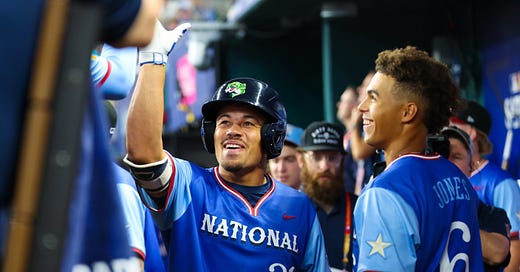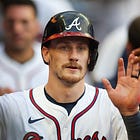What Drake Baldwin and Nacho Alvarez need to do to succeed in Atlanta
The team's two top position player prospects are different types of hitters - how do they work in the box, and what do they need to do to translate that to Atlanta?
The farm system of the Atlanta Braves is seen as pitcher heavy, with Atlanta having spent a higher percentage of available MLB Draft bonus pool money (61%) from 2019-2023 on pitching prospects than any other major league team.
But that doesn’t mean the farm is completely barren of position players. Two of Atlanta’s top hitting prospects, catcher Drake Baldwin and middle infielder Nacho Alvarez Jr., both finished last year in Triple-A Gwinnett and in the case of Alvarez, actually got a bit of major league service time as well.
What improvements does Atlanta need to see for them to get run in 2025?
Drake Baldwin: Great swing decisions
Atlanta’s top position player prospect, Baldwin’s knocking on the door of the major leagues but is currently blocked by Sean Murphy and the (expected) return of Travis d’Arnaud.
But with yesterday’s trade of Jorge Soler, I can see a path to consistent playing time for Drake Baldwin.
Marcell Ozuna is expected to return on his $16M club option for his age 34 season. So is d’Arnaud on a $8M deal for his age 36 season.
It’s likely, but not certain, that neither is back for 2026.
Assuming both get through 2025 healthy, which as 2024 showed us, isn’t a guarantee, it’s easy to see how Atlanta could be content to leave Baldwin in Gwinnett for the entire season to finish the “extra” work that comes with being a young catcher in the league and then bring him up for 2026.
Here’s Alex Anthopoulos, talking about that, after the season ended:
And the relevant quote, if you don’t want to spend two minutes on that clip:
“The young catching position, to me, it’s like breaking in a glove, right? There’s just so much more to it with the information ]…] there is so much thrown at these guys with the game planning, game calling, beyond the fact that offensively and everything else that I don’t think you can ever go wrong at that position getting more time to develop.”
Alex reiterated that Baldwin would have been an option had more injuries hit behind the plate and that “he’s just a phone call away” in Gwinnett, but it’s not a quote from someone eager to promote the kid up to give him regular at-bats in 2025.
Most of the work remaining for Baldwin is intangible stuff - gamecalling, defense, handling a pitching staff, etc. Offensively, he’s a standout in a position without very many of them, because his swing decisions are bordering on elite.
The two things I look at to evaluate swing decisions are zone swing percentage versus chase percentage - in essence, how much more are you swinging at pitches in the zone versus out of the zone?
There’s no hard and fast rule here, but a 3-to-1 ratio feels right.
Drake Baldwin’s ZSwing% last season was 74.18%, while his chase was 22.9%, a ratio of 3.24-to-1. That’s Elite.1
Not only does he have elite swing decisions, he also makes an above-average rate of quality contact. Baldwin’s 79.2% contact rate is 74th percentile in AAA, with his 90th percentile exit velocity of 106.2 mph coming in well above average at 77th percentile.2
If there is an offensive issue Baldwin needs to clean up prior to getting his first MLB shot, it’s his launch angles. His average launch angle is just 7.59 degrees, indicative of his ground ball issues. He ran a 50% ground ball rate in AAA, a factor which will hold his overall offensive profile back until it’s fixed.
But once Baldwin gets more consistent at lifting the ball, he’s a ready-made impact performer at the major league level.
It’s entirely possible that your 2026 playing time division between Sean Murphy and Drake Baldwin looks similar to the 2022 season, where Travis d’Arnaud made the lion’s share of starts behind the plate (99 of 162) and William Contreras divided his time between catching (57 games) and designated hitter (31). Murphy starting 100 games at catcher and DH-ing 40 times feels like the ideal way to keep him going offensively, something the Braves sorely need.
And if injuries strike again next season, taking either Murphy or d’Arnaud out of commission for a while, Baldwin is in the mix (along with Chadwick Tromp) to come up in 2025.
Nacho Alvarez Jr: Great contact, but not much power
It’s harder to figure out the exact fit for Alvarez, because of multiple factors: The defensive questions, his struggles last season in his (brief) call-up last season, and the different offensive profile from Baldwin.
Alvarez is a very passive hitter, swinging well less than average. His 41.88% swing percentage is 9th percentile for AAA last season, only ramping up to a whopping 11th percentile mark of 62.2% for pitches in the zone.
Now, when Alvarez swings, he usually makes contact - a 82.1% overall contact rate (87th percentile) and a 87.39% contact mark in the zone (76th percentile).
The issue is that he’s just not making a lot of HARD contact: Alvarez’s 90EV is just 101.5 mph, good for 15th percentile in AAA. Alvarez also has some of Baldwin’s issues lifting the ball, with a 46% ground ball rate in Gwinnett last season.
It feels like a higher floor but a lower ceiling than Baldwin owing to the lack of power…unless he’s running a high average and OBP (which is possible - he walked 13.5% of the time in the minors last season).
When you combine that with the questions about his defense - most evaluators consider him to be average at best at shortstop, owing to the lack of foot speed and overall range - it puts more pressure on his bat to pick up the slack.
Ultimately, I expect to see both players at the major league level in 2025. But how much run they get - and what kind of impact they can have with those at-bats - still remains to be seen.
BONUS: Friend of the program Chris Clegg of The Dynasty Dugout hopped on the pod with us last week to discuss this farm system, including both Baldwin and Alvarez.
Not just my opinion - Baseball America defines elite swing decisions as a ZSwing% of >74% and a Chase% of <27%.
MLB average for 90EV is around 103 mph.





I know this is a crazy idea. With David Fletcher pitching as a knucleballer the entire year last year in AA. What are the odds he is the teams ultility guy and he starts as a pitcher for the team every 10 games or so. He also can come in when the regular starter just doesn't have it. Instead of having 'the' Jesse take on 3 innings to save the pen etc--could Fletcher come in and be that extra pitcher? He could save the pen at times and then give the starters an extra day of rest. I hope they go with a 6 man rotation and also allow Fletcher to fill in to reset the entire rotation over and over. We can't seem to have healthy starters when the braves are fortunate to get to the post season--so anything out of the box may help, who knows. I know this is wrong, but it would be fun to try (for me at least). On a 1-10 rank how just truly insane is this? Thanks.